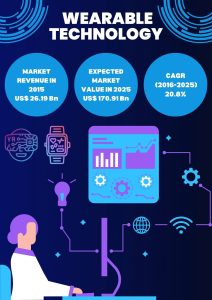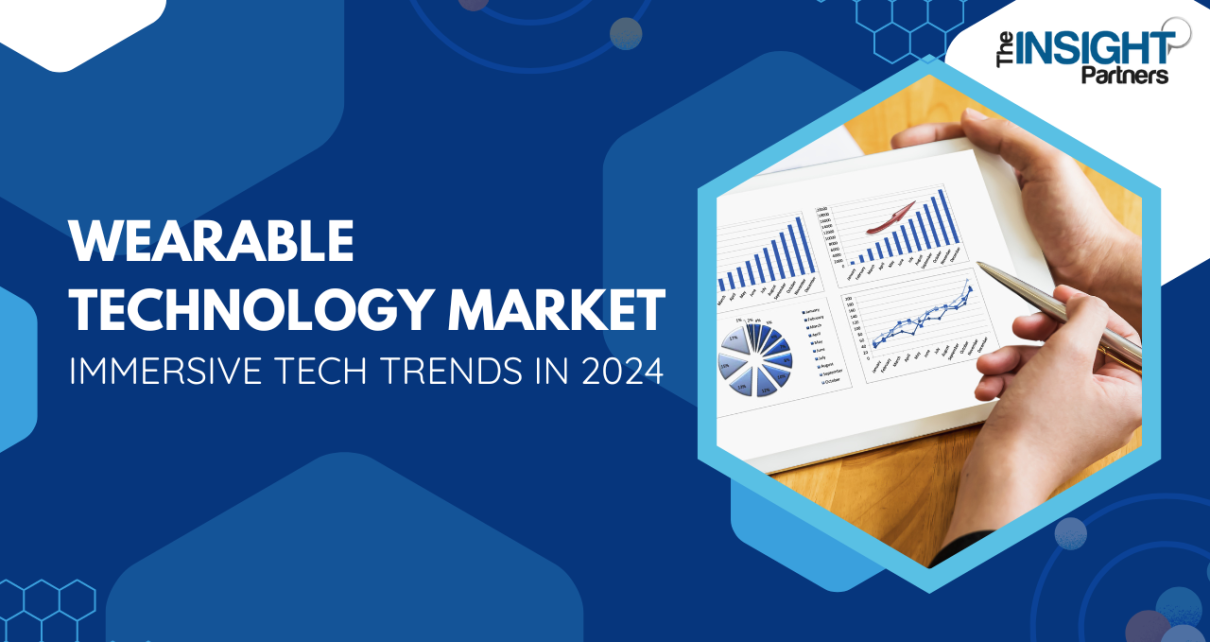Rapid developments are occurring in digital technologies together with the electronic and mobile sectors. The businesses have turned towards the innovation element more to differentiate. Wearable technologies have increased their popularity and become a focus of interest. Businesses are creating new markets and producing new innovative products. The wearable technology market has exploded. The focus has shifted to emerging technology along with the design. Product design is vital to commercial success as consumers want to buy a device that complements their desired look. The wearable technology market is expected to see shipments nearly double by the end of the forecast period.

Since the wearable technology market’s inception, it’s been a matter of getting products out in the market to generate awareness and interest. Presently it’s about getting the experience right. From the way hardware looks and feels, to how software collects, analyses, and presents insightful data. The wearable technology market products will be treated as second and third-generation devices. This will make today’s devices seem quaint. A decline in prices will make these more affordable to a larger crowd. The diversity is expected to be spearheaded by big boosts in two particular genres of wearable tech. Smart Clothing and earwear have the most potential.
Smart clothing allows digital and electronic components to be embedded into them. These fabrics are made with innovative and advanced technology. This is to deliver value to the wearer. It comes under two categories. Namely performance enhancing and aesthetic. Performance-enhancing fabrics help regulate the body temperature, control music vibration and decrease wind resistance. This enhances athletic comfort and performance, greatly impacting extreme sports, defense, and athletics. Aesthetics are fabrics that can change color and collect energy from the environment. They do it by sound or heat, harnessing vibrations reacting to this input.
Other fabrics include clothes designed to safeguard against environmental hazards such as radiation. Earwear includes devices that bring additional functionality to a regular pair of earphones. They sync with various smartphone applications. The introduction of smart clothing facilitates growth in the wearable technology market.
Tech-savvy Millennials Accelerate Growth in the Wearable Technology Market
The wearable technology market is a segment within the broader consumer electronics market. It focuses specifically on devices that can be worn or integrated into clothing or accessories. It is equipped with various sensors, connectivity features, and computing capabilities.
Millennials have grown up with technology while representing the new era of talent. They expect everything to be under control and at their fingertips. This is one of the major factors that has helped redefine consumer consumption and buying patterns lately. The busy lifestyle adopted globally has compelled consumers to get inclined toward a digital life. The proliferation of smart technologies has significantly facilitated a specular shift from a general to a digital lifestyle. This is an indicator that points to a rise in revenue for consumer electronics vendors soon.
The availability of devices stimulating the automation of daily chores drastically changed consumers’ preferences. They shifted from general single-purpose electronic products to multi-functional smart devices. Consumer electronics-producing companies flourished on the surge in demand for various wearable, smart home, and other consumer electronic devices. The increased Internet of Things (IoT) facilitates increased safety. This improves product quality and performance. This facilitates growth in the demand for consumer electronics. The growth accelerates the expansion of the global wearable technology market.
Many wearable devices rely on similar technological components found in traditional consumer electronics. These include processors, sensors, displays, and connectivity modules. For instance, smartwatches sync with smartphones to display notifications. The AR/VR devices might connect to gaming consoles or computers for immersive experiences. The convergence of these markets continues to drive innovation. They offer a wide range of devices that cater to diverse consumer needs and preferences.
Adoption of Wearable Technology in the Healthcare Sector Accelerates Demand
Wearable technologies are involved in several sectors but have a particular impact on the health sector. Using wearable technologies, private data is transferred to smart devices via smart detectors. The individual’s follow-up related to their medical condition is fulfilled properly. Wearable health technology products are turning into a need rather than a personal choice every passing day. With their use aimed at increasing the wealth of communities, they have become handy in the medical sector.
Wearable injectors are drug delivery systems developed for single-use wearable technology. This is intended to provide patients with substantial amounts of medication over an extended period. The wearable injectors are small and portable. They allow the patient to conveniently self-administer the medications. They can do so while performing daily activities at home or work.
The prevalence of chronic diseases such as diabetes, cancer, autoimmune disorders, and cardiovascular conditions drives the demand in the wearable injectors market. The wearable injectors market has attracted significant investment from pharmaceutical companies and medical device vendors. This leads to the development of advanced devices and the expansion of the wearable technology market globally.
It is seen that the wearable technology market is rapidly developing in the medical sector. An increase in the demand for products may increase people’s quality of life. It makes instant health follow-up and eases their lives. This will create a market potential for the businesses. Thus, the wearable health technology market is considered a very attractive market for both producers and consumers.
Synergy of VR and Wearable Technology to Aid in Market Expansion
Virtual Reality (VR) has been developed dramatically in recent years. Numerous market domains are adopting VR for a diverse range of applications. In the field of computer graphics, VR has become a significant instrument. This is due to its benefits of providing an engaging and immersive environment. Current wearable technology centered in the medical and healthcare fields has grown. Various types of controllers are being developed along with the development of virtual reality interfaces. The synergy between these sectors presents opportunities for innovation and expanded applications across industries.
Virtual reality refers to a simulated environment created by computer technology. It is typically experienced through VR headsets or glasses. It immerses users in a digital environment. They can interact with the artificial environment as if they were physically present. VR devices are equipped with sensors, and displays, and often require connectivity to a computing device (like a PC, console, or smartphone). This makes them a technologically advanced wearable gadget. Growth opportunities include further advancements in display technologies for better resolution. The virtual reality market is a specialized segment within the wearable technology landscape. It offers immersive experiences through wearable devices.
With advancements in wearable technology, fitness and wellness landscapes are being rewritten. Consumers are empowered to lead their health and wellness movement. Wearable devices offer comprehensive fitness tracking, personalized coaching, and stylish designs that integrate with virtual reality algorithms. Consumers can proactively manage and monitor their health, leading to revolutionized self-care. It is likely to experience continued growth soon as wearable technology advances for both patients and healthcare providers.
The wearable fitness devices incorporate gamification elements such as virtual badges, virtual rewards, and challenges. This keeps active users engaged and motivated. The integration of a social element provided by many health clubs encourages healthy competition.
Future Trends in the Wearable Technology Market
Wearable technology has progressed significantly since its conception. Their potential is growing constantly with new scientific discoveries and technological developments. The future opportunities presented by wearable technology are multifaceted. From improving personalized care to assisting medical professionals remotely in monitoring their patients’ disease, the market is on a trajectory of growth.
Advancements in Health Monitoring
The next generation of medical devices is likely to be less invasive. They will be able to give quantitative real-time measurements of biomarkers in point-of-care settings. Continuous monitoring of a patient’s biomarkers could alert care professionals. They can take immediate and timely action. This would be particularly valuable within intensive care settings where patient health can deteriorate rapidly.
The future of the wearable healthcare gadget market looks encouraging. With open doors in remote patient monitoring systems and home medical services, the market will grow. Wearable devices are expected to see significant advancements in health monitoring capabilities. Improvements in sensor technology and data analysis algorithms will enable wearables to provide more comprehensive and accurate health insights.
Seamless Integration with Everyday Attire
One of the key future trends is the seamless integration of technology into everyday attire. This includes the development of smart fabrics that incorporate sensors or even flexible electronics directly into clothing. This makes wearables more discreet and comfortable. This integration aims to make wearable devices less obtrusive and more fashionable, encouraging wider adoption. We are slowly moving towards a point where users will have a small chemical lab on their wrist. The ability for them to access the data generated will open opportunities for improving the health of the world’s population.
The next generation of wearable technology will further blur the division between wellness and medical devices. This is due to improved analytical ability. With advancements in artificial intelligence (AI) and machine learning, wearables are anticipated to provide more personalized insights and recommendations. These devices will learn from users’ habits, preferences, and health data. They will offer tailored suggestions for fitness routines, health management, stress reduction techniques, and overall lifestyle improvements. This expected trend signifies a shift toward more sophisticated, user-centric wearable technology. This not only tracks physical activity but also focuses on holistic health management and seamless integration into daily life.
Competitive Potential in the Wearable Technology Market
In the highly competitive wearable technology market, companies employ various strategies to gain a competitive edge, expand market share, and differentiate themselves from their rivals. A growing number of startups are launching wearable technology around the world. Staying ahead in the wearable technology market requires continuous innovation. Companies invest heavily in research and development. This is to introduce cutting-edge features and functionalities.
Strong branding helps create recognition and loyalty among consumers. Companies emphasize unique selling points and user experience to differentiate their products from competitors. Collaborations with other companies, healthcare institutions, fitness organizations, or fashion brands can be a powerful strategy. The key players in the market are looking to consolidate their position post-pandemic. The prime domain of focus of market players is adapting to the evolving consumer demands through innovation and development. By focusing on user comfort, ease of use, and delivering actionable insights, companies can build a loyal customer base. This encourages repeat purchases.
References:
DergiPark- Wearable Technology Market within the Scope of Digital Health
IET Digital Library- Wearable Technology and Product Design



